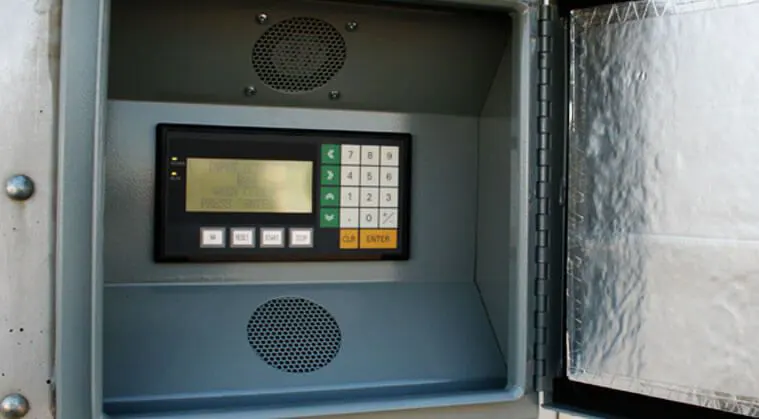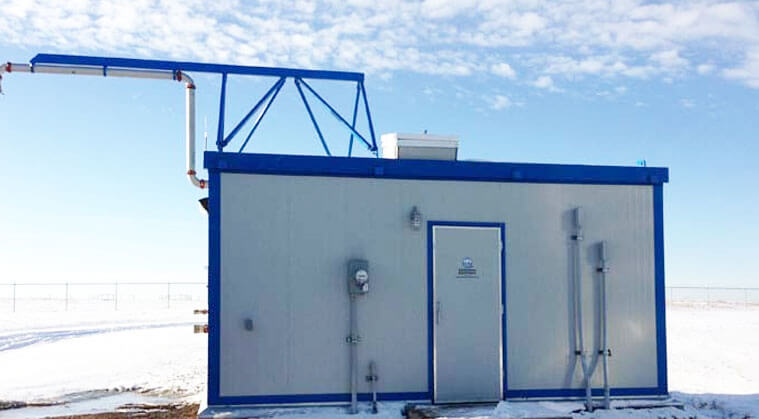For the most part, capital costs for piped water systems in Northern climates have traditionally been high. These systems also face operating challenges during periods of extreme cold. Above-ground systems are common, as an installation in the permafrost brings its own challenges.
As a result, northern communities address water distribution challenges by utilizing bulk water dispensing truckfill stations to meet their needs.
Bulk water dispensing stations offer communities a safe and cost-effective water distribution method well suited to northern climates.
Advancement of dispensing systems has allowed for standalone, automated stations, which can be conveniently located to facilitate customer access. All while ensuring the security of supply and control over the water distribution system is continuous.
Northern US: Ninilchik, Alaska
The community of Ninilchik, Alaska has a bulk water filling station to meet their water dispensing needs. This community sits on the western coast of the Kenai Peninsula on Cook Inlet, has a population of about 900 residents, and traces its settlement back to 1847.
Traditionally, people have obtained water by hauling it or drawing it from wells.However, it may vary significantly in quality and source from household to household.
A bulk dispensing station can effectively meet the community’s needs. Yet, as with all northern communities, unique considerations have been specified for the station design process.
The average temperatures of Ninilchik range from 7C (45F) to 15C (59F) in the summer. In the winter months it can be between -10C (14F) to -3C (27F). While less extreme than in many other northern communities, these operating conditions needed to be addressed when planning infrastructure.
To address these concerns, the team insulated the station enclosure to prevent heat loss and installed a second heater to provide backup heat inside the station.
The external access terminal uses a steel access box, and warm air from the interior circulates over the terminal to provide constant heat to exposed screens and control devices.

In addition, these systems boost revenue by capturing and recording every customer transaction. The software then uses this information to automatically generate invoices, which further reduces administration costs.
In addition to northern climate considerations, the Ninilchik station stands serves residents and trucking firms. It handles varying volume needs, and was fabricated with an automated coin operation feature.
This system will allow users to pay at the station with cash, simplifying the management of station payments and thus lowering administration costs.
The team upgraded the system with thicker steel walls on the access terminal. Such upgrades deter vandalism and ensure the security of any on-site payments.
The automation features built into the Ninilchik system allow the municipality to control access by creating customer accounts.
Once set up, customer usage and the information used to generate invoices can be automatically tracked. These features provide monitoring, security, and control over access to the community’s water supply.
These systems also boost revenue by capturing and recording every customer transaction. The software then uses this data to automatically generate invoices and drive administration costs even lower.
Crow Reservation, MT
When northern communities select a bulk water dispensing system, they can choose anything from a simple access terminal added to an existing municipal system to a standalone, turn-key bulk water dispensing unit that connects to the community’s water source and power.

Preassembled systems like the station in Ninilchik are factory tested so they arrive in the community ready to run, making installation straightforward. Suppliers customize modern bulk water dispensing systems to meet each purchaser’s specific requirements.
Operators can tailor flow rates to match customers’ tank sizes, and they can design multiple distribution points into a single filling station to serve many users at once.
Northern Canada: Whitehorse, Yukon
The climate considerations of the North may require additional insulation, heating, or circulation systems to ensure reliable operation and safety of the system. Some communities may even opt to install their stations on heated pads to prevent any spilled water from freezing.
A recently constructed station in Whitehorse shows how designs vary by community: it includes different fill-line sizes, protection against weather and freezing, and a chlorine residual monitoring system for all potable water dispensed.
MD 124 – Smith, Alberta
Bulk water stations can include automated data capture and communications capability. Options include cellular, internet, or satellite links, which may vary depending on the infrastructure available within the community.
Lessons learned
For projects to be successful in the unique operating environment of the North, they must be tailored to the specific needs of the communities they serve.
Improving the security of a community’s dispensing system, increasing revenue, and lower costs are all measures of a successful project.

In remote areas, a single station may service an entire community, so system reliability and the ability to provide continuous access to all users are key factors in system selection.
Successful delivery of these projects depends on careful planning and execution, as well as reliable access to remote technical expertise.
It takes experience working with northern communities and cooperation between clients, engineers, and suppliers to meet these challenges.


